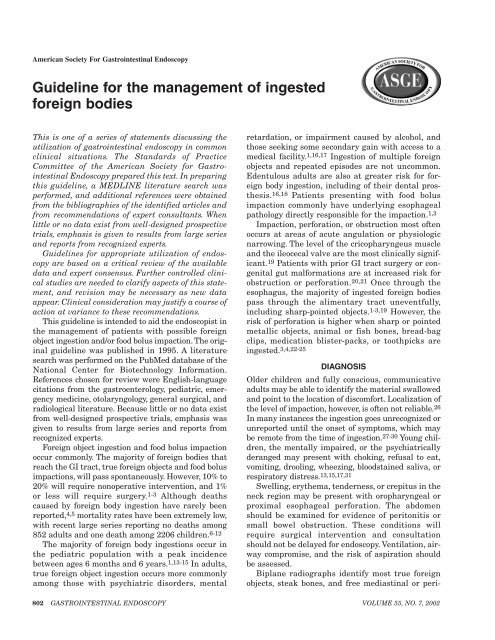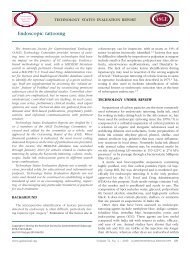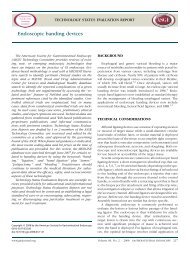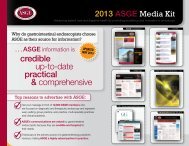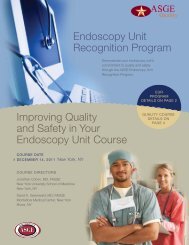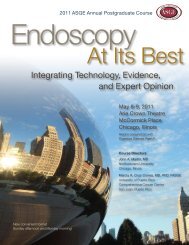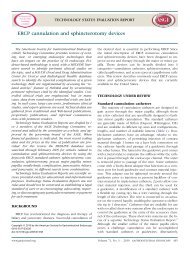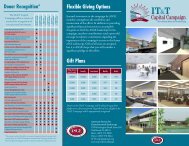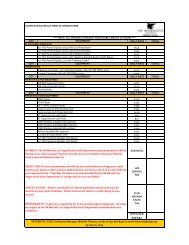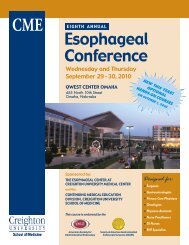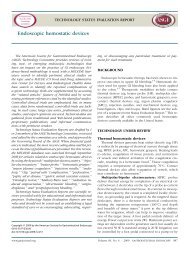Guideline for the management of ingested foreign bodies - American ...
Guideline for the management of ingested foreign bodies - American ...
Guideline for the management of ingested foreign bodies - American ...
- No tags were found...
You also want an ePaper? Increase the reach of your titles
YUMPU automatically turns print PDFs into web optimized ePapers that Google loves.
<strong>American</strong> Society For Gastrointestinal Endoscopy<strong>Guideline</strong> <strong>for</strong> <strong>the</strong> <strong>management</strong> <strong>of</strong> <strong>ingested</strong><strong>for</strong>eign <strong>bodies</strong>This is one <strong>of</strong> a series <strong>of</strong> statements discussing <strong>the</strong>utilization <strong>of</strong> gastrointestinal endoscopy in commonclinical situations. The Standards <strong>of</strong> PracticeCommittee <strong>of</strong> <strong>the</strong> <strong>American</strong> Society <strong>for</strong> GastrointestinalEndoscopy prepared this text. In preparingthis guideline, a MEDLINE literature search wasper<strong>for</strong>med, and additional references were obtainedfrom <strong>the</strong> bibliographies <strong>of</strong> <strong>the</strong> identified articles andfrom recommendations <strong>of</strong> expert consultants. Whenlittle or no data exist from well-designed prospectivetrials, emphasis is given to results from large seriesand reports from recognized experts.<strong>Guideline</strong>s <strong>for</strong> appropriate utilization <strong>of</strong> endoscopyare based on a critical review <strong>of</strong> <strong>the</strong> availabledata and expert consensus. Fur<strong>the</strong>r controlled clinicalstudies are needed to clarify aspects <strong>of</strong> this statement,and revision may be necessary as new dataappear. Clinical consideration may justify a course <strong>of</strong>action at variance to <strong>the</strong>se recommendations.This guideline is intended to aid <strong>the</strong> endoscopist in<strong>the</strong> <strong>management</strong> <strong>of</strong> patients with possible <strong>for</strong>eignobject ingestion and/or food bolus impaction. The originalguideline was published in 1995. A literaturesearch was per<strong>for</strong>med on <strong>the</strong> PubMed database <strong>of</strong> <strong>the</strong>National Center <strong>for</strong> Biotechnology In<strong>for</strong>mation.References chosen <strong>for</strong> review were English-languagecitations from <strong>the</strong> gastroenterology, pediatric, emergencymedicine, otolaryngology, general surgical, andradiological literature. Because little or no data existfrom well-designed prospective trials, emphasis wasgiven to results from large series and reports fromrecognized experts.Foreign object ingestion and food bolus impactionoccur commonly. The majority <strong>of</strong> <strong>for</strong>eign <strong>bodies</strong> thatreach <strong>the</strong> GI tract, true <strong>for</strong>eign objects and food bolusimpactions, will pass spontaneously. However, 10% to20% will require nonoperative intervention, and 1%or less will require surgery. 1-3 Although deathscaused by <strong>for</strong>eign body ingestion have rarely beenreported, 4,5 mortality rates have been extremely low,with recent large series reporting no deaths among852 adults and one death among 2206 children. 6-12The majority <strong>of</strong> <strong>for</strong>eign body ingestions occur in<strong>the</strong> pediatric population with a peak incidencebetween ages 6 months and 6 years. 1,13-15 In adults,true <strong>for</strong>eign object ingestion occurs more commonlyamong those with psychiatric disorders, mentalretardation, or impairment caused by alcohol, andthose seeking some secondary gain with access to amedical facility. 1,16,17 Ingestion <strong>of</strong> multiple <strong>for</strong>eignobjects and repeated episodes are not uncommon.Edentulous adults are also at greater risk <strong>for</strong> <strong>for</strong>eignbody ingestion, including <strong>of</strong> <strong>the</strong>ir dental pros<strong>the</strong>sis.16,18 Patients presenting with food bolusimpaction commonly have underlying esophagealpathology directly responsible <strong>for</strong> <strong>the</strong> impaction. 1,3Impaction, per<strong>for</strong>ation, or obstruction most <strong>of</strong>tenoccurs at areas <strong>of</strong> acute angulation or physiologicnarrowing. The level <strong>of</strong> <strong>the</strong> cricopharyngeus muscleand <strong>the</strong> ileocecal valve are <strong>the</strong> most clinically significant.19 Patients with prior GI tract surgery or congenitalgut mal<strong>for</strong>mations are at increased risk <strong>for</strong>obstruction or per<strong>for</strong>ation. 20,21 Once through <strong>the</strong>esophagus, <strong>the</strong> majority <strong>of</strong> <strong>ingested</strong> <strong>for</strong>eign <strong>bodies</strong>pass through <strong>the</strong> alimentary tract uneventfully,including sharp-pointed objects. 1-3,19 However, <strong>the</strong>risk <strong>of</strong> per<strong>for</strong>ation is higher when sharp or pointedmetallic objects, animal or fish bones, bread-bagclips, medication blister-packs, or toothpicks are<strong>ingested</strong>. 3,4,22-25DIAGNOSISOlder children and fully conscious, communicativeadults may be able to identify <strong>the</strong> material swallowedand point to <strong>the</strong> location <strong>of</strong> discom<strong>for</strong>t. Localization <strong>of</strong><strong>the</strong> level <strong>of</strong> impaction, however, is <strong>of</strong>ten not reliable. 26In many instances <strong>the</strong> ingestion goes unrecognized orunreported until <strong>the</strong> onset <strong>of</strong> symptoms, which maybe remote from <strong>the</strong> time <strong>of</strong> ingestion. 27-30 Young children,<strong>the</strong> mentally impaired, or <strong>the</strong> psychiatricallyderanged may present with choking, refusal to eat,vomiting, drooling, wheezing, bloodstained saliva, orrespiratory distress. 13,15,17,31Swelling, ery<strong>the</strong>ma, tenderness, or crepitus in <strong>the</strong>neck region may be present with oropharyngeal orproximal esophageal per<strong>for</strong>ation. The abdomenshould be examined <strong>for</strong> evidence <strong>of</strong> peritonitis orsmall bowel obstruction. These conditions willrequire surgical intervention and consultationshould not be delayed <strong>for</strong> endoscopy. Ventilation, airwaycompromise, and <strong>the</strong> risk <strong>of</strong> aspiration shouldbe assessed.Biplane radiographs identify most true <strong>for</strong>eignobjects, steak bones, and free mediastinal or peri-802 GASTROINTESTINAL ENDOSCOPY VOLUME 55, NO. 7, 2002
TitleAuthortoneal air. The lateral projection confirms location in<strong>the</strong> esophagus and may reveal <strong>the</strong> presence <strong>of</strong> morethan one coin. However, fish or chicken bones, wood,plastic, most glass, and thin metal objects are notreadily seen. 13 A contrast examination should not beper<strong>for</strong>med routinely because <strong>of</strong> <strong>the</strong> risk <strong>of</strong> aspirationand because coating <strong>of</strong> <strong>the</strong> <strong>for</strong>eign body andesophageal mucosa compromises subsequent endoscopy.19 If symptoms are not clear or specific, a cautiouscontrast study may be appropriate to clarify<strong>the</strong> presence <strong>of</strong> a <strong>for</strong>eign body or its location. 32,33 CTscanning may be useful in some cases but may benegative with radiolucent objects and <strong>the</strong> yield maybe improved with <strong>the</strong> use <strong>of</strong> 3D reconstruction. 34-36Handheld metal detectors detect <strong>the</strong> majority <strong>of</strong>swallowed metallic objects and may be <strong>of</strong> use as ascreening tool in pediatric patients. 37 Persistentsymptoms related to <strong>the</strong> esophagus in cases <strong>of</strong> suspected<strong>for</strong>eign body ingestion should be pursuedwith endoscopy even after an apparently unrevealingradiographic evaluation. 19MANAGEMENTGeneralOnce <strong>for</strong>eign body ingestion is diagnosed, <strong>the</strong> physicianmust decide whe<strong>the</strong>r or not intervention is necessary,what degree <strong>of</strong> urgency is called <strong>for</strong>, and bywhat means. Management is influenced by <strong>the</strong>patient’s age and clinical condition; <strong>the</strong> size, shape,and classification <strong>of</strong> <strong>the</strong> <strong>ingested</strong> material; <strong>the</strong>anatomic location in which <strong>the</strong> object is lodged; and<strong>the</strong> technical abilities <strong>of</strong> <strong>the</strong> endoscopist. 19,38The timing <strong>of</strong> endoscopic intervention in <strong>for</strong>eignbody ingestion is dictated by <strong>the</strong> perceived risks <strong>of</strong>aspiration and/or per<strong>for</strong>ation. Urgent endoscopicintervention is required when a sharp object or diskbattery is lodged in <strong>the</strong> esophagus. Urgent interventionis also required to prevent aspiration when an<strong>ingested</strong> <strong>for</strong>eign object or food bolus impaction createsa high-grade obstruction and <strong>the</strong> patient is unable tomanage his or her secretions. Those without evidence<strong>of</strong> high-grade obstruction who are not in acute distresscan be handled less urgently because spontaneouspassage may occur. 1-3,39 Under no circumstancesshould a <strong>for</strong>eign object or food bolus impaction beallowed to remain in <strong>the</strong> esophagus beyond 24 hoursfrom presentation. 1,19 In children, <strong>the</strong> duration <strong>of</strong> <strong>the</strong><strong>for</strong>eign body in <strong>the</strong> esophagus may be unknown.Complications such as transmural erosion and fistulae<strong>for</strong>mation can occur. When <strong>the</strong> duration <strong>of</strong> <strong>the</strong>esophageal <strong>for</strong>eign body is not known, <strong>the</strong> endoscopyis best per<strong>for</strong>med with <strong>the</strong> patient under generalanes<strong>the</strong>sia, and surgical consultation is suggested.Rigid and flexible esophagoscopy are both safeand effective methods <strong>of</strong> removing variousesophageal <strong>for</strong>eign <strong>bodies</strong>. 1,40 Rigid esophagoscopyrequires general anes<strong>the</strong>sia. Flexible endoscopy isper<strong>for</strong>med with <strong>the</strong> patient under conscious sedationor general anes<strong>the</strong>sia depending on <strong>the</strong> patient’s age,ability to cooperate, and <strong>the</strong> type and number <strong>of</strong>objects to be retrieved. Rigid esophagoscopy or directlaryngoscopy may be attempted <strong>for</strong> impacted sharpobjects at <strong>the</strong> level <strong>of</strong> <strong>the</strong> hypopharynx and cricopharyngeusmuscle. 13 Flexible endoscopy is preferred inmost o<strong>the</strong>r circumstances because it is successful in<strong>the</strong> majority <strong>of</strong> pediatric patients and allows a thoroughexamination <strong>of</strong> <strong>the</strong> esophagus, stomach, andduodenum. 1,14,16,41,42EquipmentStandard and <strong>the</strong>rapeutic endoscopes are preferred,although successful <strong>management</strong> <strong>of</strong> swallowed <strong>for</strong>eignobjects with a transnasally inserted bronchoscopehas been described. 42 Equipment that shouldbe readily available includes rat tooth and alligator<strong>for</strong>ceps, polypectomy snare, polyp grasper, Dormierbasket, retrieval net, overtubes <strong>of</strong> esophageal andgastric lengths, and a <strong>for</strong>eign body protector hood. 43Practice at grasping a similar object with <strong>the</strong> availableinstruments outside <strong>the</strong> patient is beneficial.Use <strong>of</strong> an overtube <strong>of</strong>fers airway protection duringretrieval, allows <strong>for</strong> multiple passes <strong>of</strong> <strong>the</strong> endoscopeduring removal <strong>of</strong> multiple <strong>for</strong>eign <strong>bodies</strong> or afood impaction, and protects <strong>the</strong> esophageal mucosafrom lacerations during retrieval <strong>of</strong> sharpobjects. 44,45 In children, <strong>the</strong> overtube is less commonlyused because <strong>of</strong> <strong>the</strong> risk <strong>of</strong> esophageal injuryduring <strong>the</strong> overtube insertion. The <strong>for</strong>eign body protectorhood is preferable in protecting <strong>the</strong> esophagusduring removal <strong>of</strong> sharp or pointed objects. Electiveendotracheal intubation is an alternative means <strong>of</strong>assuring airway protection.Food bolus impactionThe most common esophageal <strong>for</strong>eign body in adultsis impacted meat or o<strong>the</strong>r food bolus. 1 Patients whoare in severe distress or unable to swallow oralsecretions require immediate intervention. If <strong>the</strong>patient is not uncom<strong>for</strong>table, not at risk <strong>for</strong> aspiration,and able to handle his or her secretions, <strong>the</strong>nintervention need not be emergent and can be postponedto a reasonably convenient time because foodimpactions will <strong>of</strong>ten pass spontaneously. 1 However,endoscopic intervention should not be delayedbeyond 24 hours from presentation because <strong>the</strong> risk<strong>of</strong> complication may increase. 46The initial endoscopic examination should verifyand locate <strong>the</strong> site <strong>of</strong> <strong>the</strong> impaction. The food boluscan usually be removed en bloc or in a piecemealfashion with <strong>the</strong> instruments described above. AsVOLUME 55, NO. 7, 2002 GASTROINTESTINAL ENDOSCOPY 803
AuthorTitlepreviously stated, an overtube may facilitate multiplepasses <strong>of</strong> <strong>the</strong> endoscope, protect <strong>the</strong> esophagealmucosa, and minimize <strong>the</strong> risk <strong>of</strong> aspiration. Oncereduced in size, <strong>the</strong> bolus can <strong>of</strong>ten be passed underendoscopic visualization and direction. When <strong>the</strong>endoscope, with insufflation and distention <strong>of</strong> <strong>the</strong>esophageal lumen, can be steered around <strong>the</strong> foodbolus and into <strong>the</strong> stomach, <strong>the</strong> endoscope can <strong>the</strong>nbe pulled back and used to gently push <strong>the</strong> bolusinto <strong>the</strong> stomach. 47,48 The high incidence <strong>of</strong> underlyingesophageal pathology in this setting increases<strong>the</strong> risk associated with <strong>the</strong> practice <strong>of</strong> blindly pushingan impacted food bolus with <strong>the</strong> endoscope or adilator. 3 A friction-fit adaptor fitted to <strong>the</strong> end <strong>of</strong> <strong>the</strong>endoscope has been used as a direct-vision suctiondevice to remove <strong>the</strong> impacted food. 49,50A protyolytic enzyme, like papain, should not beused because it has been associated with hypernatremia,erosion, and esophageal per<strong>for</strong>ation. 1,51,52The administration <strong>of</strong> glucagon 1.0 mg intravenously,in an attempt to relax <strong>the</strong> esophagus, is generallysafe and may promote spontaneous passage <strong>of</strong> animpacted food bolus while definitive endoscopic<strong>the</strong>rapy is being coordinated. 53,54 However, its useshould not delay definitive endoscopic removal.Blunt objectsCoins can be removed easily with a <strong>for</strong>eign body <strong>for</strong>ceps(“rat-tooth,” “alligator”), snare, or a retrievalnet. 1,19,43 Smooth, round objects are best securedwith a retrieval net or basket, although in a prospectivein vivo study <strong>the</strong> retrieval net was superior. 38Objects that cannot be easily grasped in <strong>the</strong> esophagusmay be advanced into <strong>the</strong> stomach, if endoscopicvisualization is af<strong>for</strong>ded, where <strong>the</strong>y may be moreeasily grasped. Nonendoscopic removal <strong>of</strong> bluntradiopaque esophageal <strong>for</strong>eign objects with a Foleyca<strong>the</strong>ter under fluoroscopic guidance has beenreported to be successful with a low complicationrate, but provides no control <strong>of</strong> <strong>the</strong> object as it isbeing removed, provides no airway protection, anddoes not allow <strong>for</strong> assessment <strong>of</strong> underlyingesophageal pathology. 19,55,56 Conservative outpatient<strong>management</strong> is indicated in almost allinstances in which <strong>the</strong> <strong>for</strong>eign body has entered <strong>the</strong>stomach, 13-15,57 although in some institutions endoscopicremoval is <strong>the</strong> standard practice. 16,41 Mostobjects are passed within 4 to 6 days, although somemay take as long as 4 weeks. While awaiting spontaneouspassage <strong>of</strong> a <strong>for</strong>eign body, patients are usuallyinstructed to continue a regular diet andobserve <strong>the</strong>ir stools <strong>for</strong> <strong>the</strong> <strong>ingested</strong> object. In <strong>the</strong>absence <strong>of</strong> symptoms, weekly radiographs are sufficientto follow <strong>the</strong> progression <strong>of</strong> small blunt objectsnot observed to pass spontaneously. 1,3,14 In adults,rounded objects greater than 2.5 cm in diameter areless likely to pass <strong>the</strong> pylorus. Objects that fail toleave <strong>the</strong> stomach within 3 to 4 weeks should beremoved endoscopically. Once <strong>the</strong> object is past <strong>the</strong>stomach, surgical removal should be considered <strong>for</strong>objects that remain in <strong>the</strong> same location <strong>for</strong> morethan 1 week. 1,19 Symptoms <strong>of</strong> fever, vomiting, orabdominal pain are indications <strong>for</strong> immediate surgicalevaluation.Long objectsObjects longer than 6 to 10 cm, such as toothbrushesand spoons, will have difficulty passing <strong>the</strong> duodenalsweep and should be removed. 16,58 The use <strong>of</strong>a longer (>45 cm) overtube that extends beyond <strong>the</strong>gastroesophageal junction is beneficial. The objectcan be grasped with a snare or basket and maneuveredinto <strong>the</strong> overtube. The entire apparatus, <strong>for</strong>eignbody, overtube, and endoscope can <strong>the</strong>n bewithdrawn in one motion, avoiding losing grasp <strong>of</strong><strong>the</strong> object in <strong>the</strong> overtube itself. 59Sharp-pointed objectsA myriad <strong>of</strong> <strong>ingested</strong> sharp-pointed objects havebeen described. The ones most commonly associatedwith complications are chicken and fish bones,straightened paperclips, toothpicks, needles, breadbagclips, and dental bridgework. Patients suspected<strong>of</strong> swallowing sharp-pointed objects must be evaluatedto define <strong>the</strong> location <strong>of</strong> <strong>the</strong> object. Becausemany sharp-pointed objects are not readily visibleradiographically, endoscopy should follow a negativeradiologic examination. Sharp-pointed objectslodged in <strong>the</strong> esophagus represent a medical emergency.Direct laryngoscopy is an alternative <strong>for</strong>objects lodged at or above <strong>the</strong> cricopharyngeus.O<strong>the</strong>rwise, rigid or flexible endoscopy may be usedwhen this is unsuccessful or <strong>for</strong> objects lodged belowthis area. Although <strong>the</strong> majority <strong>of</strong> sharp-pointedobjects that enter <strong>the</strong> stomach will pass through <strong>the</strong>remaining GI tract without incident, <strong>the</strong> risk <strong>of</strong> acomplication caused by a sharp-pointed object is ashigh as 35%. 3 There<strong>for</strong>e, a sharp-pointed object thathas passed into <strong>the</strong> stomach or proximal duodenumshould be retrieved endoscopically if it can beaccomplished safely. 1,3,22 O<strong>the</strong>rwise sharp-pointedobjects may be followed with daily radiographs todocument <strong>the</strong>ir passage, and surgical interventionshould be considered <strong>for</strong> objects that fail to progress<strong>for</strong> 3 consecutive days. 1 Patients should be instructedto immediately report abdominal pain, vomiting,persistent temperature elevations, hematemesis, ormelena. Endoscopic retrieval <strong>of</strong> sharp objects isaccomplished with use <strong>of</strong> retrieval <strong>for</strong>ceps orpolypectomy snare. 38 The risk <strong>of</strong> mucosal injury804 GASTROINTESTINAL ENDOSCOPY VOLUME 55, NO. 7, 2002
TitleAuthorduring sharp object retrieval can be minimized byorienting <strong>the</strong> object with point trailing duringextraction, using an overtube, or fitting a protectorhood to <strong>the</strong> end <strong>of</strong> <strong>the</strong> endoscope. 19,60Disk batteriesSpecial considerations apply with small disk or buttonbattery ingestion. 61,62 Liquefaction necrosis andper<strong>for</strong>ation can occur rapidly when a disk battery islodged in <strong>the</strong> esophagus. After radiographic documentation,batteries lodged in <strong>the</strong> esophagus shouldbe immediately recovered because <strong>of</strong> possible fatalcomplications. A stone retrieval basket or retrievalnet is most <strong>of</strong>ten successful. An alternative methoduses a through-<strong>the</strong>-scope balloon under directvision. The balloon is passed through <strong>the</strong> workingchannel <strong>of</strong> <strong>the</strong> endoscope, distal to <strong>the</strong> <strong>for</strong>eign body.The balloon is inflated and withdrawn to engage <strong>the</strong>battery. The balloon, battery, and endoscope are <strong>the</strong>nremoved as a unit. 1 The use <strong>of</strong> an overtube or endotrachealtube is essential to protect <strong>the</strong> airway during<strong>the</strong> per<strong>for</strong>mance <strong>of</strong> this procedure.If <strong>the</strong> battery cannot be directly retrieved from<strong>the</strong> esophagus, it should be pushed into <strong>the</strong> stomachwhere it can <strong>of</strong>ten be successfully retrieved with abasket. However, once in <strong>the</strong> stomach, most diskbatteries pass without consequence. Batteries thathave passed beyond <strong>the</strong> esophagus need not beretrieved unless <strong>the</strong> patient manifests signs orsymptoms <strong>of</strong> injury to <strong>the</strong> GI tract, or a large-diameterbattery (greater than 20 mm in diameter)remains in <strong>the</strong> stomach beyond 48 hours as determinedby a repeat radiograph. 61 Once past <strong>the</strong> duodenalsweep, 85% are passed within 72 hours. 63 Aradiograph every 3 to 4 days is adequate. Emeticshave not been beneficial in <strong>the</strong> <strong>management</strong> <strong>of</strong> diskbattery ingestions and have led to retrograde migration<strong>of</strong> gastric batteries into <strong>the</strong> esophagus. 61Cathartics and acid suppression have no proven rolein battery ingestion although GI lavage may expeditepassage. 64Narcotic packetsInternal concealment <strong>of</strong> narcotics wrapped in plasticor contained in latex condoms, referred to as “bodypacking,” is seen in regions <strong>of</strong> high drug traffic. 65The packets can usually be seen radiographicallyand <strong>the</strong> use <strong>of</strong> CT scanning may be helpful, althoughfalse-negative scans have been reported. 34,35Rupture and leakage <strong>of</strong> <strong>the</strong> contents can be fatal. Noattempt should be made to remove drug packetsendoscopically because <strong>of</strong> <strong>the</strong> risk <strong>of</strong> rupture.Surgical intervention is indicated <strong>for</strong> failure <strong>of</strong> <strong>the</strong>packets to progress, signs <strong>of</strong> intestinal obstruction,or suspected rupture.REFERENCES1. Webb WA. Management <strong>of</strong> <strong>for</strong>eign <strong>bodies</strong> <strong>of</strong> <strong>the</strong> upper gastrointestinaltract: update. Gastrointest Endosc 1995;41:39-51.2. Nandi P, Ong GB. Foreign body in <strong>the</strong> esophagus: review <strong>of</strong>2394 cases. Br J Surg 1978;65:5-9.3. Vizcarrondo FJ, Brady PG, Nord HJ. Foreign <strong>bodies</strong> <strong>of</strong> <strong>the</strong> uppergastrointestinal tract. Gastrointest Endosc 1983;29:208-10.4. Simic MA, Budakov BM. Fatal upper esophageal hemorrhagecaused by a previously <strong>ingested</strong> chicken bone: case report. AmJ Forensic Med Pathol 1998;19:166-8.5. Bennet DR, Baird CJ, Chan KM, Crookes PF, Bremner CG,Gottlieb MM, et al. Zinc toxicity following massive coin ingestion.Am J Forensic Med Pathol 1997;18:148-53.6. Webb WA. Management <strong>of</strong> <strong>for</strong>eign <strong>bodies</strong> <strong>of</strong> <strong>the</strong> upper gastrointestinaltract: update. Gastrointest Endosc 1995;41:39-51.7. Chu KM, Choi HK, Tuen HH, Law SYK, Branicki FJ, Wong J.A prospective randomized trial comparing <strong>the</strong> use <strong>of</strong> <strong>the</strong> flexiblegastroscope versus <strong>the</strong> bronchoscope in <strong>the</strong> <strong>management</strong><strong>of</strong> <strong>for</strong>eign body ingestion. Gastrointest Endosc 1998;47:23-7.8. Velitchkov NG, Grigorov GI, Losan<strong>of</strong>f JE, Kjossev KT.Ingested <strong>for</strong>eign <strong>bodies</strong> <strong>of</strong> <strong>the</strong> gastrointestinal tract: retrospectiveanalysis <strong>of</strong> 542 cases. World J Surg 1996;20:1001-5.9. Cheng W, Tam PK. Foreign-body ingestion in children in children:experience with 1265 cases. J Pediatr Surg 1999;34:1472-6.10. Kim JK, Kim SS, Kim JI, Kim SW, Yang YS, Cho SH, et al.Management <strong>of</strong> <strong>for</strong>eign <strong>bodies</strong> in <strong>the</strong> gastrointestinal tract: ananalysis <strong>of</strong> 104 cases in children. Endoscopy 1999;31:302-4.11. Hachimi-Idrissi S, Corne L, Vandenplas Y. Management <strong>of</strong><strong>ingested</strong> <strong>for</strong>eign <strong>bodies</strong> in childhood: our experience andreview <strong>of</strong> <strong>the</strong> literature. Eur J Emerg Med 1998;5:319-23.12. Panieri E, Bass DH. The <strong>management</strong> <strong>of</strong> <strong>ingested</strong> <strong>for</strong>eign <strong>bodies</strong>in children-a review <strong>of</strong> 663 cases. Eur J Emerg Med1995;2:83-7.13. Cheng W, Tam PK. Foreign-body ingestion in children in children:experience with 1265 cases. J Pediatr Surg 1999;34:1472-6.14. Panieri E, Bass DH. The <strong>management</strong> <strong>of</strong> <strong>ingested</strong> <strong>for</strong>eign <strong>bodies</strong>in children—a review <strong>of</strong> 663 cases. Eur J Emerg Med1995;2:83-7.15. Hachimi-Idrissi S, Corne L, Vandenplas Y. Management <strong>of</strong><strong>ingested</strong> <strong>for</strong>eign <strong>bodies</strong> in childhood: our experience andreview <strong>of</strong> <strong>the</strong> literature. Eur J Emerg Med 1998;5:319-23.16. Blaho KE, Merigian KS, Winbery SL, Park LJ, Cockrell M.Foreign body ingestions in <strong>the</strong> emergency department: casereports and review <strong>of</strong> treatment. J Emerg Med 1998;16:21-6.17. Kamal I, Thompson J, Paquette DM. The hazards <strong>of</strong> vinylglove ingestion in <strong>the</strong> mentally retarded patient with pica:new implications <strong>for</strong> surgical <strong>management</strong>. Can J Surg1999;42:201-4.18. Abdullah BJJ, Teong LK, Mahadevan J, Jalaludin A. Dentalpros<strong>the</strong>sis <strong>ingested</strong> and impacted in <strong>the</strong> esophagus and orolaryngopharynx.J Otolaryngol 1998;27:190-4.19. Ginsberg GG. Management <strong>of</strong> <strong>ingested</strong> <strong>for</strong>eign objects andfood bolus impactions. Gastrointest Endosc 1995;41:33-8.20. Macmanus JE. Per<strong>for</strong>ation <strong>of</strong> <strong>the</strong> intestine by <strong>ingested</strong> <strong>for</strong>eign<strong>bodies</strong>. JAMA 1941;53:393-402.21. Benjamin SB. Small bowel obstruction and <strong>the</strong> Garren-Edwards gastric bubble: an iatrogenic bezoar. GastrointestEndosc 1988;34:463-7.22. Selivanov V, Sheldon GF, Cello JP, Crass RA. Management <strong>of</strong><strong>for</strong>eign body ingestion. Ann Surg 1984;199:187-91.23. Newell KJ, Taylor B, Walton JC, Tweedie EJ. Plastic breadbagclips in <strong>the</strong> gastrointestinal tract: report <strong>of</strong> 5 cases andreview <strong>of</strong> <strong>the</strong> literature. CMAJ 2000;162:527-9.24. Yamada T, Sato H, Seki M, Kitagawa S, Nakagawa M,VOLUME 55, NO. 7, 2002 GASTROINTESTINAL ENDOSCOPY 805
AuthorTitleShimazaki H. Successful salvage <strong>of</strong> aortoesophageal fistulacaused by a fish bone. Ann Thorac Surg 1996;61:1843-5.25. Chan FK, Sung JJ, Tam PY, Kwong KH, Lau JY. “Blisterpack”-induced gastrointestinal hemorrhage. Am J Gastroenterol1996;92:172-3.26. Connolly AA, Birchall M, Walsh-Waring GP, Moore-Gillon V.Ingested <strong>for</strong>eign <strong>bodies</strong>: patient guided localization is a usefulclinical tool. Clin Otolaryngol 1992;17:520-4.27. Adams DB. Endoscopic removal <strong>of</strong> entrapped coins from anintraluminal duodenal diverticulum 20 years after ingestion.Gastrointest Endosc 1986;32:415-6.28. Kirberg AE. Long standing esophageal <strong>for</strong>eign body.Gastrointest Endosc 1986;32:304-5.29. Yamamoto M. A chopstick is removed after 60 years in <strong>the</strong>duodenum. Gastrointest Endosc 1985;31:51.30. Tsui BCH, Mossey J. Occults liver abscess following clinicallyunsuspected ingestion <strong>of</strong> <strong>for</strong>eign <strong>bodies</strong>. Can J Gastroenterol1997;11:445-8.31. Choudhurg CR, Bricknell MC, MacIver D. Oesophageal <strong>for</strong>eignbody: an unusual cause <strong>of</strong> respiratory symptoms in athree-week-old baby. J Laryngol Otol 1992;106:556-7.32. Seikel K, Primm PA, Elizondo BJ, Remley KL. Handheldmetal detector localization <strong>of</strong> <strong>ingested</strong> metallic <strong>for</strong>eign <strong>bodies</strong>.Arch Pediatr Adolesc Med 1999;153:853-7.33. Bassett KE, Schunk JE, Logan L. Localizing <strong>ingested</strong> coinswith a metal detector. Am J Emerg Med 1999;17:338-41.34. Cranston PE, Pollack CV, Harrison RB. CT <strong>of</strong> crack cocaineingestion. J Comput Assist Tomogr 1992;16:560-3.35. Eng JGH, Aks SE, Marcus C, Issleib S. False-negative abdominalCT scan in a cocaine body stuffer. Am J Emerg Med1999;17:702-4.36. Takada M, Kashiwagi R, Sakane M, Tabata F, Kuroda Y. 3D-CT diagnosis <strong>for</strong> <strong>ingested</strong> <strong>for</strong>eign <strong>bodies</strong>. Am J Emerg Med2000;18:192-3.37. Doraiswamy NV, Baig H, Hallam L. Metal detector and swallowedmetal <strong>for</strong>eign <strong>bodies</strong> in children. J Accid Emerg Med1999;16:123-5.38. Faigel DO, Stotland BR, Kochman ML, Hoops T, Judge T,Kroser J, et al. Device choice and experience level in endoscopic<strong>for</strong>eign object retrieval: an in vivo study. GastrointestEndosc 1997;45:490-2.39. Bendig DW, Machel GG. Management <strong>of</strong> smooth-blunt gastric<strong>for</strong>eign <strong>bodies</strong> in asymptomatic patients. Clin Pediatr1990;29:642-5.40. Herranz-Gonzalez J, Martinez-Vidal J, Bardin-SaranderesaC, Vazquez-Barro C. Esophageal <strong>for</strong>eign <strong>bodies</strong> in adults.Otolaryngol Head Neck Surg 1991;105:649-54.41. Kim JK, Kim SS, Kim JI, Kim SW, Yang YS, Cho SH, et al.Management <strong>of</strong> <strong>for</strong>eign <strong>bodies</strong> in <strong>the</strong> gastrointestinal tract: ananalysis <strong>of</strong> 104 cases in children. Endoscopy 1999;31:302-4.42. Chu KM, Choi HK, Tuen HH, Law SYK, Branicki FJ, Wong J.A prospective randomized trial comparing <strong>the</strong> use <strong>of</strong> <strong>the</strong> flexiblegastroscope versus <strong>the</strong> bronchoscope in <strong>the</strong> <strong>management</strong><strong>of</strong> <strong>for</strong>eign body ingestion. Gastrointest Endosc 1998;47:23-7.43. Nelson DB, Bosco JJ, Curtis W, Faigel DO, Kelsey PB, LeungJW, et al. Endoscopic retrieval devices. Gastrointest Endosc1999;50:932-4.44. Spurling TJ, Zaloga GP, Richter JE. Fiberendoscopic removal<strong>of</strong> a gastric <strong>for</strong>eign body with an overtube technique.Gastrointest Endosc 1983;29:226-7.45. Carr-Locke DL, al-Kawas FH, Branch MS, Byrne WJ,Edmundowicz SA, Jamidar PA, et al. Overtube use in gastrointestinalendoscopy. Gastrointest Endosc 1996;44:767-70.46. Chaikhouni A, Kratz JM, Craw<strong>for</strong>d FA. Foreign <strong>bodies</strong> <strong>of</strong> <strong>the</strong>esophagus. Am Surg 1985;51:173-9.47. Vicari JJ, Johanson JF, Frakes JT. Outcomes <strong>of</strong> acuteesophageal food impaction: success <strong>of</strong> <strong>the</strong> push technique.Gastrointest Endosc 2001;53:178-81.48. Longstreth GF, Longstreth KJ, Yao JF. Esophageal foodimpaction: epidemiology and <strong>the</strong>rapy. A retrospective, observationalstudy. Gastrointest Endosc 2001;53:193-8.49. Saeed ZA, Michaletz PA, Feiner SD, Woods KL, Graham DY.A new endoscopic method <strong>for</strong> managing food impactions.Endoscopy 1990;22:226-8.50. Pezzi JS, Shiau YF. A method <strong>for</strong> removing meat impactionsfrom <strong>the</strong> esophagus. Gastrointest Endosc 1994;40:634-6.51. Anderson HA, Bernatz PE, Grindlay JH. Per<strong>for</strong>ation <strong>of</strong> <strong>the</strong>esophagus after use <strong>of</strong> a digestive agent: report <strong>of</strong> a case andexperimental study. Ann Otol Rhinol Laryngol 1959;68:890.52. Holsinger JW, Furson RL, Sealy WC. Esophageal per<strong>for</strong>ationfollowing meat impaction and papain ingestion. JAMA1968;204:188.53. Ferruci TJ, Long JA. Radiologic treatment <strong>of</strong> esophageal foodimpaction using intravenous glucagon. Radiology 1977;125:25-8.54. Trenkner SW, Maglinte D, Lehman GA, Chernish SM, MillerRE, Johnson CW. Esophageal food impaction: treatment withglucagon. Radiology 1983;149:401.55. Schunk JE, Harrison AM, Corneli HM, Nixon GW. Fluoroscopicfoley ca<strong>the</strong>ter removal <strong>of</strong> esophageal <strong>for</strong>eign <strong>bodies</strong> in children:experience in 415 episodes. Pediatrics 1994;96:791-2.56. Faigel DO, Fennerty MB. Miscellaneous diseases <strong>of</strong> <strong>the</strong> esophagus.In: Yamada T, editor. Textbook <strong>of</strong> gastroenterology.Philadelphia: Lippincott Williams & Wilkins; 1999. p. 1304-25.57. Stringer MD, Capps SN. Rationalizing <strong>the</strong> <strong>management</strong> <strong>of</strong>swallowed coins in children. Br Med J 1991;302:1321-2.58. Pellerin D, Fortier-Beaulieu M, Guegen J. The fate <strong>of</strong> swallowed<strong>for</strong>eign <strong>bodies</strong>: experience <strong>of</strong> 1250 instances <strong>of</strong> subdiaphragmatic<strong>for</strong>eign <strong>bodies</strong> in children. Prog Pediatr Radiol1969;2:302.59. Chinitz MA, Bertrand CZ. Endoscopic removal <strong>of</strong> toothbrushes.Gastrointest Endosc 1990;36:527-30.60. Bertoni G, Sassatelli R, Conigliaro R, Bedogni G. A simplelatex protector hood <strong>for</strong> safe endoscopic removal <strong>of</strong> sharppointedgastroesophageal <strong>for</strong>eign <strong>bodies</strong>. Gastrointest Endosc1996;44:458-61.61. Litovitz TL, Schmitz BF. Ingestions <strong>of</strong> cylindrical and buttonbatteries: an analysis <strong>of</strong> 2382 cases. Pediatrics 1992;89:747-57.62. Gordon AC, Gough MH. Oesophageal per<strong>for</strong>ation after buttonbattery ingestion. Ann R Coll Surg Engl 1993;75:362.63. Litovitz TL. Battery ingestions: product accessability andclinical course. Pediatrics 1985;75:469-76.64. Namasivayam S. Button battery ingestion: a solution to adilemma. Pediatr Surg Int 1999;15:383-4.65. Lancashire MJR, Legg PK, Lowe M, Davidson SM, Ellis BW.Surgical aspects <strong>of</strong> international drug smuggling. Br Med J1988;296:1035-7.Prepared by:Standards <strong>of</strong> Practice CommitteeGlenn M. Eisen, MD, ChairTodd H. Baron, MDJason A. Dominitz, MDDouglas O. Faigel, MDJay L. Goldstein, MDJohn F. Johanson, MDJ. Shawn Mallery, MDHareth M. Raddawi, MDJohn J. Vargo II, MDJ. Patrick Waring, MDRobert D. Fanelli, SAGES RepJo Wheeler-Harbough, SGNA Rep806 GASTROINTESTINAL ENDOSCOPY VOLUME 55, NO. 7, 2002


